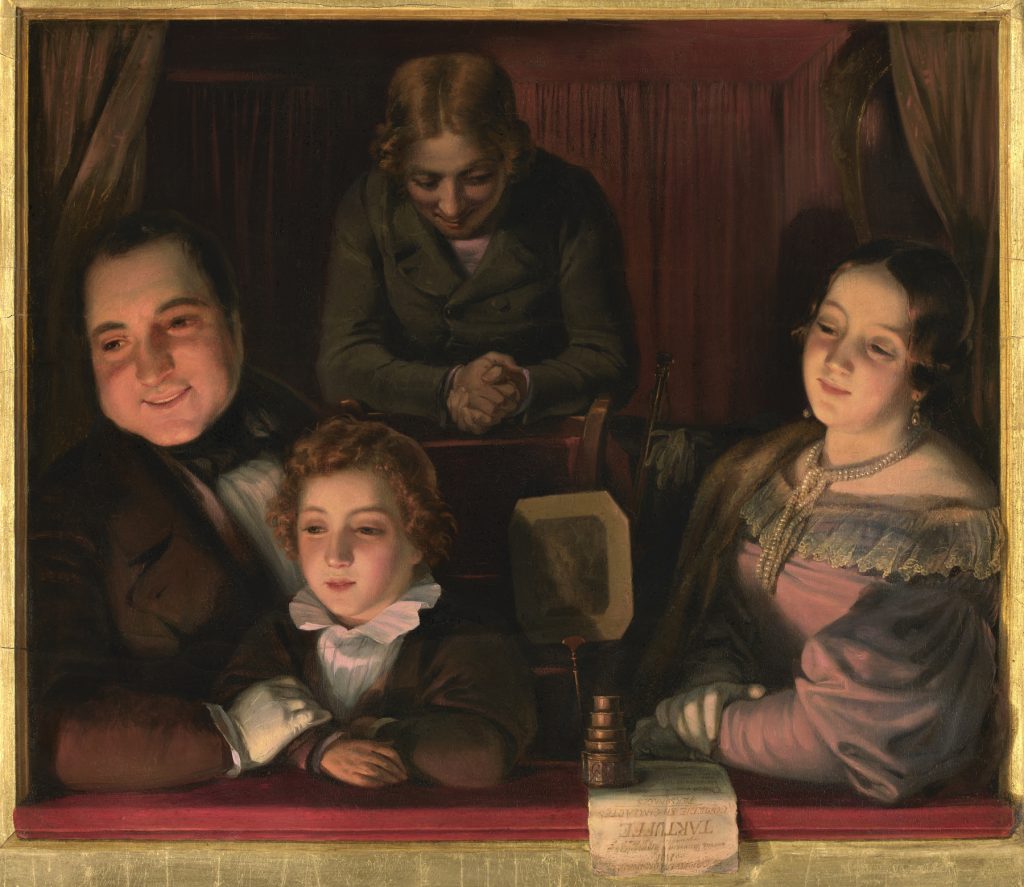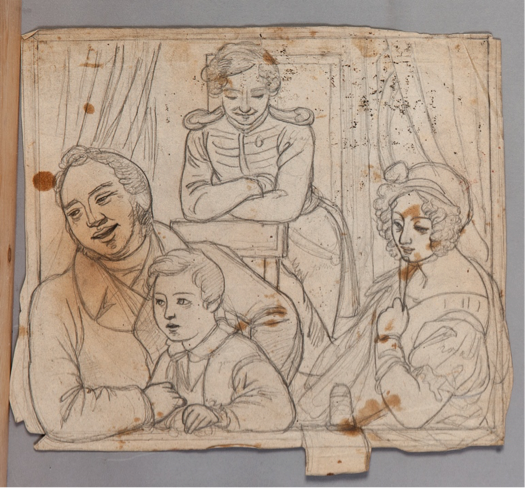Moritz Daniel Oppenheim (Hanau 1800 - 1882 Frankfurt am Main)
A Box at the Theatre, before 1839
Oil on panel embedded in its frame, c. 26 x 31 cm (panel), c. 51 x 57 cm (panel including frame)
Signed with the artist’s monogram MO on the opera glass
Provenance:
Zunz collection, Frankfurt[1] (Oppenheim’s list, 1880)
Probably 'Stuttgarter Schloß', 1900[2]
Private collection, Germany
Literature:
Georg Kaspar Nagler, Neues allgemeines Künstler-Lexicon: oder Nachrichten von dem Leben und den Werken der Maler, Bildhauer, Baumeister, Kupferstecher etc., X, Munich 1841, p.365
Friedrich von Bötticher, Malerwerke des neunzehnten Jahrhunderts, Dresden 1901, II, part 2, p.185, no. 14 [as ‘Theaterloge’]
Georg Heuberger and Anton Merk (eds.), Moritz Daniel Oppenheim. Die Entdeckung des jüdischen Selbstbewusstseins in der Kunst, exhib. cat. and catalogue raisonné, Frankfurt, Jüdisches Museum, Cologne 1999, p.371, no. V.25 [as ‘Theaterloge’]
Exhibited:
‘Kunstausstellung im Schauspielhaus’, Hamburg, spring 1839[3]
In his lifetime Moritz Daniel Oppenheim was Germany’s first truly popular Jewish artist.[4]
Moritz Daniel Oppenheim was born in Hanau in 1800, the son of a merchant. At the early age of ten he attended classes at the drawing academy in Hanau. He studied at the Munich Kunstakademie from 1817 to 1819 and later completed his studies in Paris. In the autumn of 1821 he travelled to Rome. A four-year stay in Italy followed, with visits to Umbria, Tuscany and the Campania. His contacts to the circle of German artists working in Rome – particularly Joseph Anton Koch, Friedrich Overbeck, Julius Schnorr von Carolsfeld and Peter Cornelius – greatly influenced his artistic development. He moved in high-society circles and mixed with numerous patrons and collectors, among them Baron Carl Mayer von Rothschild, head of the Rothschild Bank in Naples, who purchased three of his paintings.
Oppenheim returned to Germany in 1825 and settled in Frankfurt where he quickly established himself as a highly sought-after portraitist. He met Goethe in Weimar in 1827. Goethe was later instrumental in obtaining the title of professor for him. He executed portraits of a large number of public figures like Ludwig Börne, Heinrich Heine and Mendelssohn’s sister, Fanny Hensel-Mendelssohn. He travelled extensively in Europe and was also active as an art dealer acting on behalf of the Rothschilds. In the 1850s he completed a group of paintings which was to serve as the basis for the portfolio titled Bilder aus dem altjüdischen Familienleben. He was to leave an important pictorial legacy of Jewish life in Germany.[5]
This painting depicts a frontal view of a group of spectators in a box at the theatre. A couple in evening dress and their small son are watching the performance, eyes riveted. Oppenheim places particular emphasis on the theatre programme held in place by an opera glass on the balustrade – it is a programme for a performance of Molière’s Tartuffe. The structural integration of the panel into the stucco frame gives the composition something of the presentational format of a diorama and enhances its three-dimensional quality. The frame takes on an architectural function as a component of the box. The theatre programme emerges from the picture plane onto the frame itself – a trompe-l'œil device to heighten the illusionistic effect.
Schiller described the stage, removed from the courtly context, as a signpost through bourgeois life, an unerring key to the most secret recesses of the human soul.[6] It is no surprise that Oppenheim chose to focus on the odious hypocrite Tartuffe. The play is a critique of the tendency of some to constrict the freedom of others in the name of religion, to impose their ideas on them with the aim of enhancing their social position.
Oppenheim joined a masonic lodge named ‘Zur aufgehenden Morgenröthe’ in Frankfurt in 1826. The lodge played an important role in the movement for Jewish emancipation in Frankfurt.[7] It focused chiefly on issues of religious freedom, social equality and tolerance – aims widely shared in progressive circles.
Moliere’s Tartuffe had an important influence on comedy in Jewish theatre. Comedy had developed in the frame of the Purimspiel – a good example is the Jewish enlightener Aaron Halle-Wolffsohn’s Leichtsinn und Frömmelei (1796). The Purimspiel emerged in its dramatic-musical format in the nineteenth century in Germany, influenced by opera and the changing perceptions of Jewish community life. In the wake of the Jewish Enlightenment in Germany and among representatives of the Haskalah movement, comedy was to be the preferred method of engaging and appealing to a poorly educated public.[8]
A preparatory drawing, graphite on paper, 31 x 34.6 cm, is in the collection of The Israel Museum in Jerusalem (inv. P58.08.0630).
[1] The Zunz family were members of Frankfurt’s Jewish community. See Heuberger and Merk, op. cit., p.173.
[2] Oppenheim compiled a list of his paintings in 1880 and a second list was compiled by one of the organisers of an exhibition at the Kunstverein in Frankfurt in 1900. See Heuberger and Merk, op. cit., p.358. Both lists are held at the Heinrich Heine Institute in Düsseldorf (inv. 71.154).
[3] A press comment on the ‘Kunstausstellung im Schauspielhaus’ published on 2 May 1839 reads: […] And among other works […] ‘A Box at the Theatre’ by Professor Oppenheim of Frankfurt is particularly worthy of mention. Ludwig Schorn (ed.), Kunst-Blatt, Stuttgart and Tübingen 1839, p.199. See Boetticher, op. cit., p.185.
[4] Moritz Daniel Oppenheim war bereits zu Lebzeiten der erste wirklich populäre jüdische Künstler in Deutschland. Georg Heuberger in Heuberger and Merk, op. cit., p.9.
[5] For biographical details, see Ljuba Berankova and Erik Riedel, Moritz Daniel Oppenheim. Biographie sowie Selbstzeugnisse und Erinnerungen seiner Zeitgenossen, in Heuberger and Merk, op. cit., pp.341-6.
[6] Friedrich Schiller, ‘Die Schaubühne als eine moralische Anstalt betrachtet’, in Sämtliche Werke, IV, Stuttgart 1879, pp.39-46.
<http://gutenberg.spiegel.de/buch/3328/1> (accessed 30.01.2014).
[7] See Erik Riedel, ‘Moritz Daniel Oppenheim und die Freimaurerloge Zur aufgehenden Morgenröthe’, in Heuberger and Merk, op. cit., pp.153-69.
[8] Brigitte Dalinger, Trauerspiele mit Gesang und Tanz. Zur Ästhetik und Dramaturgie jüdischer Theatertexte: Zur Ästhetik und Dramaturgie der jüdischen Dramatik, Vienna 2010, p.44.


